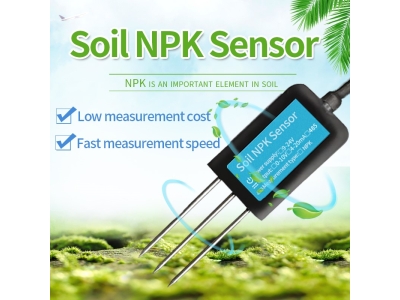Soil moisture is a critical factor in agriculture, gardening, and environmental monitoring. The ability to accurately measure soil moisture levels helps in optimizing irrigation, ensuring plant health, and conserving water resources. Soil moisture sensors are devices specifically designed to measure the amount of water content in the soil. In this article, we will explore three different types of soil moisture sensors, their principles of operation, and their applications.

1. Tensiometers:
Tensiometers are simple and widely used soil moisture sensors. They measure soil moisture based on the soil's ability to retain water under tension or suction. A tensiometer consists of a porous ceramic cup connected to a vacuum gauge. The cup is buried in the soil, and as the soil dries out, water is drawn out of the cup, creating a negative pressure or tension. This tension is measured by the vacuum gauge and provides an indication of soil moisture. The lower the reading, the drier the soil.
Tensiometers are suitable for monitoring soil moisture in areas with low to moderate soil moisture content. They are commonly used in agriculture, horticulture, and landscaping, where precise irrigation scheduling is essential. Tensiometers provide real-time data on soil moisture and help prevent over or under-watering, promoting healthier plant growth and conserving water.
2. Capacitance Sensors:
Capacitance sensors, also known as dielectric sensors, rely on the principle of electrical capacitance to measure soil moisture. These sensors consist of two electrodes inserted into the soil. The electrodes create an electrical field, and the dielectric constant of the soil affects the capacitance. The higher the soil moisture, the higher the dielectric constant, and thus the higher the capacitance. Capacitance sensors measure the changes in capacitance to determine soil moisture levels.
One of the advantages of capacitance sensors is their ability to provide continuous and accurate measurements throughout the entire soil profile. They are suitable for different soil types and can be used in a wide range of applications, including agriculture, forestry, and environmental research. Capacitance sensors are also available in various forms, including portable handheld devices and wireless systems that provide real-time data monitoring.
3. Time Domain Reflectometry (TDR) Sensors:
TDR sensors operate by measuring the time it takes for an electromagnetic pulse to travel through the soil and reflect back to the sensor. Soil moisture affects the dielectric constant of the soil, which, in turn, affects the speed of the electromagnetic pulse. TDR sensors measure the time delay and calculate soil moisture levels based on this data.
TDR sensors are known for their accuracy and precision in measuring soil moisture across various soil types and depths. They are commonly used in agricultural research, precision farming, and environmental monitoring. TDR sensors can be installed permanently in the soil or used as portable devices. They provide valuable data on soil moisture distribution and help in optimizing irrigation strategies and water management practices.
Choosing the Right Soil Moisture Sensor:
When selecting a soil moisture sensor, several factors should be considered, including the specific application, soil type, installation requirements, data collection methods, and budget constraints. It is important to choose a sensor that is suitable for the specific needs and conditions of the project.
Conclusion:
Soil moisture sensors are invaluable tools in understanding and managing soil moisture content. Tensiometers, capacitance sensors, and TDR sensors are three commonly used types of soil moisture sensors, each with its advantages and applications. By accurately measuring soil moisture levels, these sensors contribute to efficient water usage, improved crop yield, and sustainable environmental practices. Whether it is for agriculture, gardening, or scientific research, selecting the appropriate soil moisture sensor is crucial for successful soil management and water conservation efforts.





